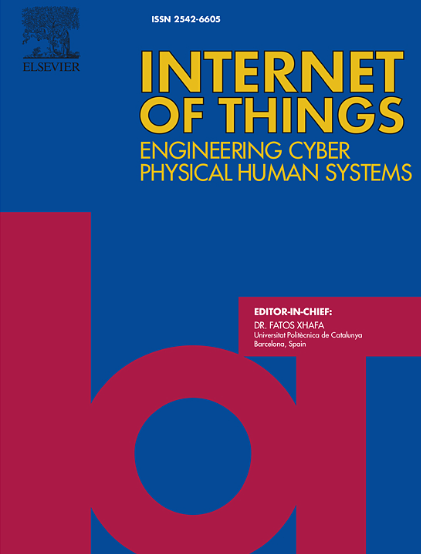3D Printed microstrip antenna for symbiotic communication: WiFi backscatter and bit rate evaluation for IoT
IF 6
3区 计算机科学
Q1 COMPUTER SCIENCE, INFORMATION SYSTEMS
引用次数: 0
Abstract
This work presents the design, experimental validation of a novel 3D-printed microstrip antenna operating at 2.4 GHz for WiFi backscatter communication in IoT applications and its performance evaluation on the communication protocol proposed in the work. The antenna is manufactured using PREPERM ABS material, which is specifically designed for high-frequency RF applications. It meets the requirements of 5G systems by ensuring high efficiency and low power loss in transmission. The antenna, integrated into the symbiotic/interference communication system, realizes low-power data transmission by utilizing existing WiFi signals. The signal power levels of each antenna in the system are tested with experimental measurements performed in a real-world environment. Then, the obtained data is used to calculate the total bit transmission rate of the system for two different scenarios proposed in the communication protocol. The proposed antenna achieves 80% efficiency, offering 10%–15% higher performance than conventional RFID-based designs, with a 5 dB gain improvement. Additionally, theoretical analysis reveals that the bit transmission rate is approximately 1.5 bps/Hz higher than experimental results, demonstrating the impact of real-world constraints on system performance. The results provide a comparative analysis of the relationship between experimental and analytical approaches in optimizing the total bit transmission rate of WiFi backscatter communication systems under different benchmarks. These findings confirm the antenna’s efficiency and enhanced performance for energy-efficient IoT applications. This research clearly demonstrates the potential of customized 3D-printed antennas and their applicability in backscatter systems to advance next-generation communication technologies.

用于共生通信的3D打印微带天线:物联网WiFi反向散射和比特率评估
本文介绍了一种用于物联网应用中WiFi反向散射通信的新型2.4 GHz 3d打印微带天线的设计和实验验证,并对工作中提出的通信协议进行了性能评估。天线采用PREPERM ABS材料制造,专为高频射频应用而设计。在传输过程中保证高效率、低功耗,满足5G系统的要求。该天线集成到共生/干扰通信系统中,利用现有WiFi信号实现低功耗数据传输。系统中每个天线的信号功率水平通过在真实环境中进行的实验测量进行了测试。然后,利用获得的数据计算系统在通信协议中提出的两种不同场景下的总比特传输率。该天线的效率达到80%,比传统的基于rfid的设计性能提高10%-15%,增益提高5db。此外,理论分析表明,比特传输速率比实验结果高约1.5 bps/Hz,证明了现实世界约束对系统性能的影响。研究结果对比分析了实验方法和分析方法在不同基准下优化WiFi后向散射通信系统总比特传输速率的关系。这些发现证实了天线的效率和增强的性能,可用于节能物联网应用。这项研究清楚地展示了定制3d打印天线的潜力及其在后向散射系统中的适用性,以推进下一代通信技术。
本文章由计算机程序翻译,如有差异,请以英文原文为准。
求助全文
约1分钟内获得全文
求助全文
来源期刊

Internet of Things
Multiple-
CiteScore
3.60
自引率
5.10%
发文量
115
审稿时长
37 days
期刊介绍:
Internet of Things; Engineering Cyber Physical Human Systems is a comprehensive journal encouraging cross collaboration between researchers, engineers and practitioners in the field of IoT & Cyber Physical Human Systems. The journal offers a unique platform to exchange scientific information on the entire breadth of technology, science, and societal applications of the IoT.
The journal will place a high priority on timely publication, and provide a home for high quality.
Furthermore, IOT is interested in publishing topical Special Issues on any aspect of IOT.
 求助内容:
求助内容: 应助结果提醒方式:
应助结果提醒方式:


